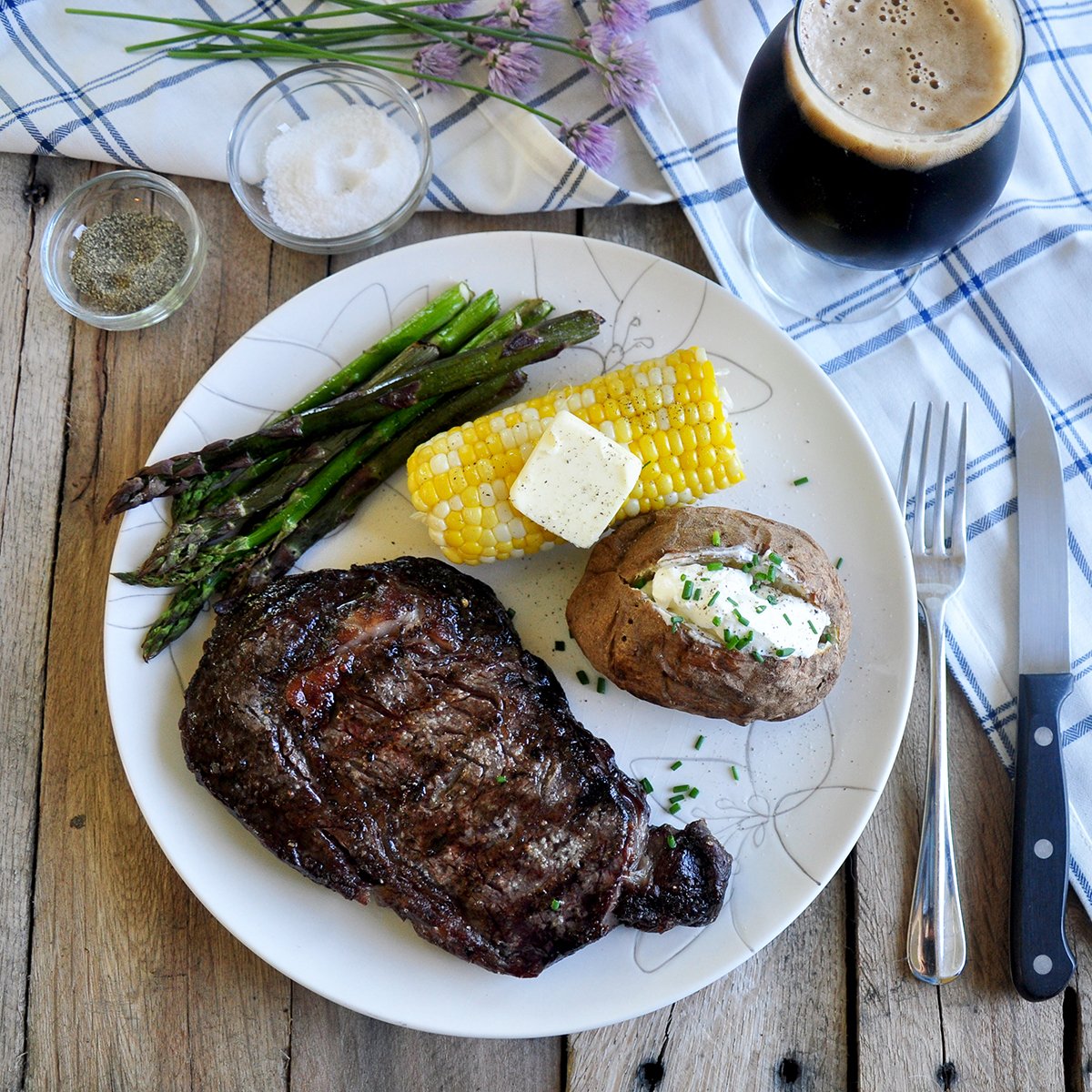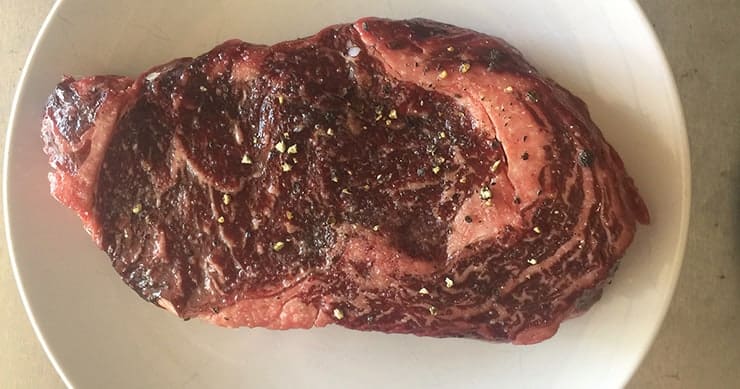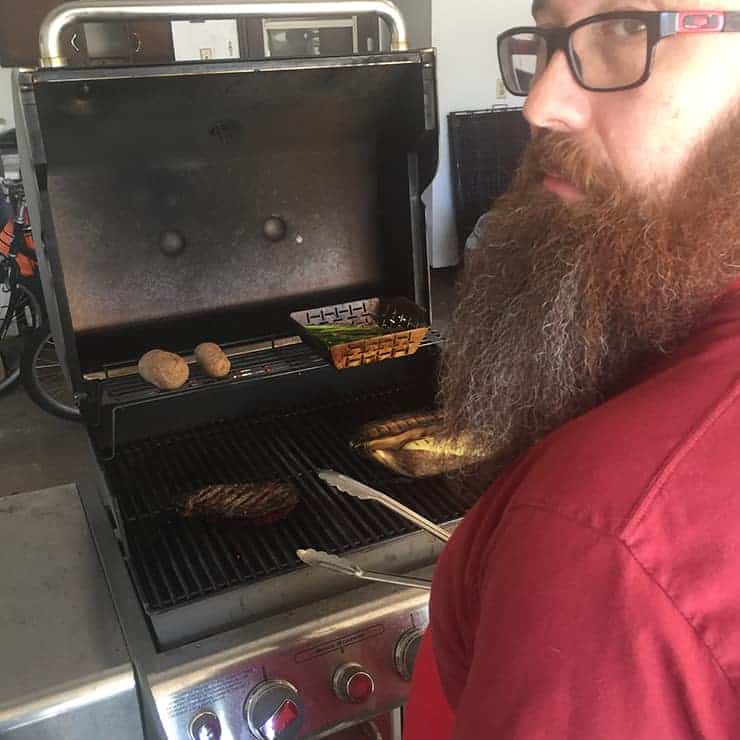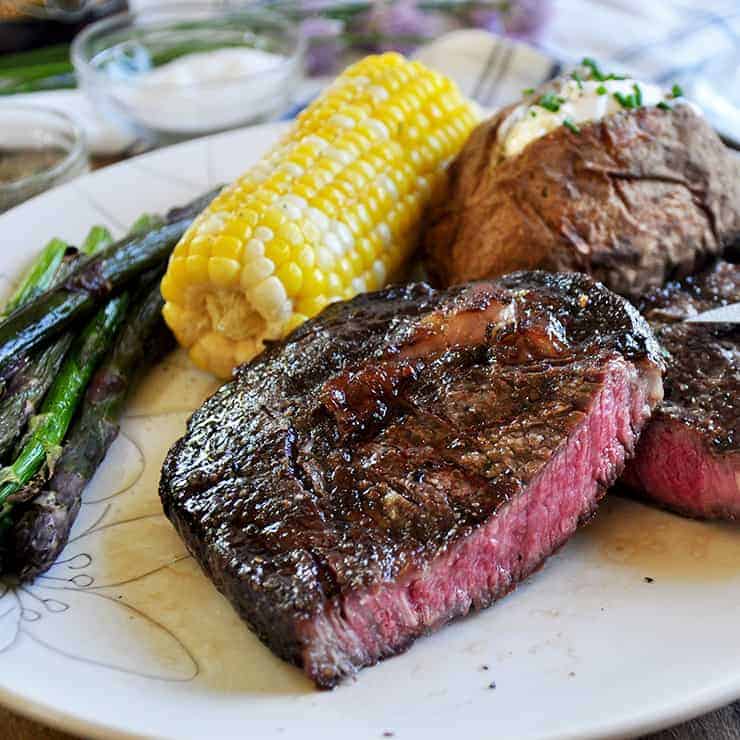This post may contain affiliate links. As an Amazon Associate I earn from qualifying purchases. Please read our disclosure policy.
Grilling steak isn’t complicated and we walk you through it all in our easy Grilling Steak Like a Boss tutorial! So, get out your notepad, grill, and learn how to make some of the best steaks of your life.

We are revisiting our grilling series because it is beautiful outside and I love getting that Weber out. What better place to start than the king of the grill; the almighty ribeye steak!? Steak is on the menu today and we are going to do our best to show you how to make an awesome slab of beef.
A great grilled steak is a pinnacle of backyard heroism the act of grilling steak is a skill that can always be improved on. So, get your grill stoked up, plan a trip to your local butcher, and follow along as we spend our time grilling steak the best we can.
Planning is Half The Battle
The reality is that grilling steak is started far before any protein hits the heat. Having the right equipment and picking the right cut of beef for the job is critical in making the best damn steak you can.
It is true that some supposedly lesser cuts of meat can be improved upon by preparing them in certain ways, but that is not our focus today. We are going to look at the cream of the crop and to get started right, you have to think about your grilling before you turn the heat on.
The Equipment
Equipment is important in grilling steak and can change how you need to cook. With a little mindfulness, the same instructions in this post can translate to any number of grills, but the grill I use is a Weber Genesis that has a sear station. I love my grill and having a gas grill makes getting set up quick, fast, and easy.
I will say that I have often considered getting a secondary charcoal grill, as there is a certain something about those charcoal flavors that is hard to replace. While I don’t have a smoker, I do have a smoke box for my Genesis, so that can help a bit with the aroma and flavor.
I did consider just purchasing a charcoal Weber instead of the Genesis but ultimately decided that the ease of a gas grill was worth it for me. I mean, if it were up to me I would have a gas grill, charcoal grill, pellet grill/smoker, and probably an electric smoker.
Do I need to get to a point where I have 10 grills and can’t afford the steak? Ha! Today, we are going to be grilling steak on my Weber Genesis!
In addition to the grill, I use tongs and tend to use a thermometer when I want a steak done exactly. If you don’t have a meat thermometer, do your self and order yourself one now. Seriously, a good thermometer is vital to grilling.
I have been known to just throw on a steak and estimate using the touch system, but I am not a pro and sometimes that can end poorly. If I am spending good money on a great steak, I will always use a thermometer.
I worked at a steak house for a bit and I remember the head cooks there indicating that they could tell the doneness by feel. These are guys who are doing this all day and sometimes they didn’t even get it right. As a backyard griller, you might have the skill to test steaks by feel, but do you want to chance it when you are spending good money on a proper steak. Get a good thermometer and use it.
Cut of Steak
Up until doing research (aka eating lots of steaks) for this series, I was a T-Bone fan. Still am a T-Bone fan. There is something about that big ol’ hunk of meat with that bone sitting in there that is special. Serious Eats has listed the four high-end steaks everybody should know as Ribeye, Strip, T-Bone (or Porterhouse), and Tenderloin.
I still am a fan of the T-bone, but my research for this thread has led me down a bit of a rabbit hole that has expanded my tastes! RIBEYE is where it is at. There are some very good reasons to choose a ribeye for your steak grilling and here are some reasons:
- The cut of meat is very uniform compared to T-Bones and Porterhouses. I said I liked T-Bones (which is actually two cuts of meat), but I have learned that a ribeye gives me a bit more control over temperature and doneness. So, the chances you are going to maximize the appropriate doneness are less in a T-Bone or Porterhouse, but you are more likely going to hit it appropriately with an even steak.
- It tends to have more fat and flavor than other cuts of meat. The tenderloin tends to be more… um… tender, but it also misses a bit of the flavor. Often, you will see tenderloins wrapped in bacon. This adds both fat and flavor to the cook. The ribeye is a great cut that has tenderness and flavor, no bacon needed. On the other end of the spectrum, the sirloin strip tends to have flavor, but it also tends to be less tender than a ribeye.
- Part of the reason I like the T-Bone is that you have this nice big bone to gnaw on. With a ribeye, you might not always get that, but you can buy it with a bone attached. If you want to get really fancy, pick up a tomahawk steak, which has a whole bunch of bone. Not all boned ribeyes have the huge tomahawk bone, however, and it is important to keep in mind that you might be paying for the experience rather than the added flavor of a huge bone.

Buying A Ribeye
So beef is graded. The grades we grill are Prime, Choice, and Select, with the quality being respectively lower in the order I listed them. Prime cuts are the cream of the crop and select tend to be lower quality. Most grocery stores will tend to have choice and select, while you can order prime cuts or your local butcher may stock them. Here in my city, prime steak does show up, but generally during special times like 4th of July or Memorial Day.
One thing to note is that a person grades these cuts visually and in bulk. So, you might find some cuts of Choice that are closer to the Prime end of things and you might find some Prime cuts that are not as great. You can occasionally find an awesome cut of meat at the grocery store that is at the top of the grade.
Likewise, you might find a Prime cut that doesn’t look so hot. For example, a while ago I was at a store that had Prime cuts, and the marbling looked beautiful. As a ribeye, however, they did not look normal. They were shaped awkwardly and did not look like something I would want to pay prime beef prices for. If I am going to pay a lot for a steak, I want the quality that it deserves.
For this post, I tried to find a cut of prime ribeye in the entire city, with no luck. That shouldn’t keep you from finding a great steak. You can do this by just looking at it. Look for nice marbling of fat within the meat. Here is a bit of an intro.
Ribeye Thickness
Leave that 1-incher in the meat case. A quality steak should be at least 1.5 inches and maybe up to 2 inches.
Grilling Steak Basics
Before I start, I have to give props to a cooking blog that I continually find inspiration from. Serious Eats has a great post on steaks that I used as a source of inspiration and want to make sure to give them credit for their food awesomeness.
In terms of steak basics, we want a sear on the outside and have a nice red to pink (I like my steak medium rare) center.
Preheat that Grill and Know Your Zones
To grill a great steak, you have to understand what a sear is and how to get it to your optimal temperature. Your grill should be broken up into zones. One portion of your grill will be extra hot. This is where you will be searing your steak.
Then, you will have a part of the grill that does not have so much heat. If you are using charcoal, this could mean having more coal on one side that is at a hotter temperature. For those of us with gas grills with multiple burners, it means having one side on high and the other side set very low.
In fact, my Weber comes with a ‘Sear Station’ that allows for a little extra heat on one side of the grill. The sear station isn’t necessary, but it does help when grilling steak to get a little extra oomph on that sear.
The Steak Sear
The nice, brown, crusty outside of the steak is created through the sear and the Maillard reaction. This is what gives off that awesome smell I always get when I pass by a neighbor’s yard when I KNOW they are grilling. The sear creates flavor and texture to the outside of the meat. While the meat itself will have a distinct flavor that hopefully, you will taste, the sear can be shared by all cuts of meat in different capacities.

The Steak Cooking
There are a few ways to do this, but I have a preference. I like to start my cook with a sear on the hot side of the grill and then move it over to the cooler side to cook until at the perfect temp.
Perhaps it is not quite baking, but it is time after the searing that brings your meat to the doneness that you prefer. I feel like it is a more foolproof way to hit that temp than the other method I mention.
There are many people who reverse sear steak. That is, they perform the cooking to bring it to doneness first and then quickly sear it at the end. This is a perfectly reasonable way to cook a steak, but not how I prefer to do this.

Grilling Steaks and Thermometers
If you know how to gauge doneness by touch, that is great. I have been to known to do this on occasion as well, but I also have had moments when I have messed up my steak.
Because of that, I like to use my thermometer most of the time. If you are spending good money on a nice ribeye, there is no shame in using a thermometer to get your desired level of doneness. I absolutely promote the use of thermometers. The level of doneness I recommend is rare to medium rare and here is a chart.
Why Do People Hate Well Done Steaks?
First, I say grill your damn steak however you want. Don’t let other people tell you how to like your food. I am guessing that 95% of the people who make fun of people for eating well-done steak don’t even really have a great reason.
They are just saying it because they heard someone else say it. I do think there are legitimate opinions that people have on the subject, but I just don’t think most people have thought about it enough and just like to be opinionated about grilling steak for the sake of it.
I did see a great thread on reddit where a chef explained it as eloquently as I have seen. He basically explains that the entire process of a great cut of meat is designed around putting a rare to medium-rare steak on your plate.
From the raising of the cattle, to the purchasing from the chef, to the recipe that shows up on your plate… it is all designed around a less-than-medium steak. If you order it well done, this chef explains that you are not going to get the meat how he means it to be served. Maybe you will be happy, but maybe not.
So, I do see that logic and there is more in that comment thread that is interesting to read. Still, at the end of the day, I like my meat red, but if you like it burnt to hell, good on you. Now, I’m not gonna lie that I probably would say something smart alecy if I bought your steak and it was a spendy slab of beef that you wanted well done. Your grill… your rules. Eat your steak how you want!
Marinade?
Nah. I am not going to say I will never use a marinade when grilling steak, but it really isn’t my thing. I feel that a great steak does not need a marinade. About an hour or so before I grill my steak, I do lightly coat it with olive oil and then generously rub salt and pepper on it. These seasonings are meant to enhance the sear and the flavor of the crust.

Sous Vide Steak
Sous Vide is the process of cooking in a temperature-controlled water bath for long periods of time, and man o man, it can make some great steaks! I am not going to cover this today, but I do want to let you know that this is a great cooking method that can involve the grill as well (still need a sear on that steak). I have a Sous Vide machine and have cooked some killer steaks with it.
Try Out Butcher Box
Of course, you could leave the steak picking to the experts and go with a service like Butcher Box where they pick the steaks for you! It really is a slick deal and you can get meat sent to you right away. Do it.
We have really covered quite a bit in our deep dive of steak grilling. I hope you learned something, as I sure did in this exploration! It was a really fun and tasty way to spend some time with these steaks. If you like what I am doing here, please subscribe to get updates by email and follow me on Instagram!
Products I Use For This Recipe
Print
Grilling Steak Like a Boss
- Prep Time: 12 Hours
- Cook Time: 10 minutes
- Total Time: 12 Hours 10 Minutes
- Yield: 4 Servings
- Category: Grilling
- Method: Grilling
- Cuisine: American
Description
There is no reason you can’t make a killer steak and this post has all the information you need to make a wonderful steak. While this recipe says the steak is four servings… and it is… it really is one serving to me. On special occasions when I am grilling steak, I want it to be awesome and I will indulge a bit!
Ingredients
- 1 Pound Ribeye
- 2 Tablespoons Olive Oil
- salt and pepper, to taste, but be generous
Instructions
- The night before, unwrap steak and put on plate in the refrigerator (optional)
- About 30 minutes before starting grill, take steak out of refrigerator and coat with olive oil.
- Rub Ribeye with salt and pepper
- Allow to sit outside of refrigerator
- Preheat grill so that you will have one zone at 500° Fahrenheit and another with indirect heat. The hot zone will be your sear side and the other will be where you cook to doneness.
- Once preheated and grates allowed to become hot, add steak to sear side for 90 seconds.
- Flip and sear the other side for 90 seconds.
- Move to the other side.
- Allow to cook for 3 more minutes on each side. The thickness of your steak will impact how quickly it cooks. Do not be afraid to measure the temps.
- Use your thermometer to get your temp. When it reaches 125° for rare, 135° for medium-rare, or 140° for medium, remove from grill.
- Allow to sit for 5 minutes
- Eat!
Notes
- Choose a thick cut of steak. At least 1.5 inches.
- Make sure to know your zones and separate cooking vs searing sections.
- By a meat thermometer to make sure you can get those exact temperatures.
- Eat steak the way you want it.
Nutrition
- Serving Size: 1 Whole Steak
- Calories: 1359
- Sodium: 221 mg
- Fat: 107 g
- Saturated Fat: 36 g
- Unsaturated Fat: 23 g
- Trans Fat: 0 g
- Carbohydrates: 0 g
- Fiber: 0 g
- Protein: 70 g
- Cholesterol: 300 mg










For what ever reason – probably mostly laziness, but also due to the fact I typically only cook on a single surface – I’ve never seared a steak. I prefer to cook it on a low temperature. I’ll admit, though, that the steaks I typically get at a restaurant are normally better than mine.
Now I’m hungry for a steak!
I am hungry for steak, as well.
Ohh that steak though, just the way I like it, still mooing and moving! 😛
Great post, Ben! My husband does all the grilling in our house, so I passed this on to him!
I’m definitely a bone-in ribeye guys, although I do enjoy a nice, thick Porterhouse once in a while, the kind you need to make a bistecca alla fiorentina. And as someone who recently overcooked a beautiful prime aged ribeye by mistake, I can tell you there’s a reason people tell you not to.
I own only a charcoal grill, so it’s too bad that we’re not next door neighbors. We could have the best of both worlds. Mine is quite large (if I do say so myself), and I do love it … but there’s no way I’m going to fire it up to grill a burger. You know what I mean? If I fire that thing up, I need to be grilling burgers for my extended family and perhaps the entire county. Nonetheless, I’ve cooked whole chickens and whole turkeys in it, which I’ve enjoyed. And of course steaks! But I’m no grilling expert, so I’m always eager to read up on it – so thanks for the info!
So, are you moving to Fargo then? 😉
Muito bom!!
Why the 2 stars? 🙁
Prime is generally found in high-end restaurants, but you can find Prime locally if you look and it is the right time!